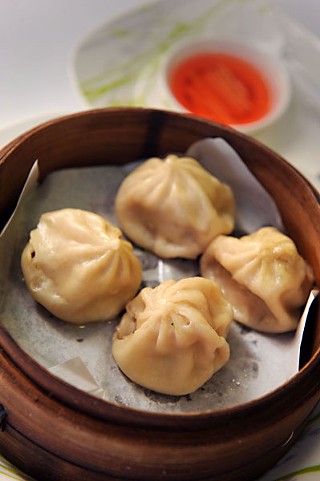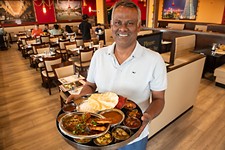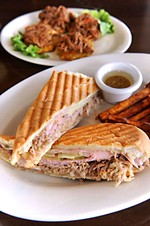Seeking XLB
In search of the mystical soup dumpling, xiao long bao
Reviewed by Mick Vann, Fri., Feb. 15, 2013
Chinese soup dumplings, translated into English as xiao long bao (known as "XLB" to aficionados), are the ultimate of all forms of dim sum. Once you've had soup dumplings, you'll look for them on every dim sum menu you cross, and in every steam basket on every cart that rumbles by your table. Soup dumplings are not wontons or dumplings plopped into a bowl of soup. They are small, semitranslucent steamed buns that contain ground pork (or better yet, pork mixed with shrimp, or, even better still, pork with crab meat and roe). Inside each little bun is a mini lake of the richest gelatinous broth of chicken or pork, or a combo of the two. I'm Homering-out just describing them.
XLBs are not that easy to find here in Austin. Residents of cities like Los Angeles, San Francisco, Houston, and New York City have the luxury of arguing over who makes the best from the many choices they have; we are not so lucky, but they are available at three places (see sidebar). I spoke with the owners at a couple of my favorite Chinese restaurants and heard the same refrain: People here don't know what xiao long bao are, they're a pain to make properly, and they take up too much kitchen space in the process.
Chinese dumplings are said to have begun near the end of the Eastern Han Dynasty with Zhang Zhongjing (AD150-219), a famous northern Chinese medicinal herbalist known as "The Medicine Saint." He noticed many people with frostbitten ears upon returning to his home village one winter and decided that a viable cure might be minced mutton, medicinal herbs, and chile wrapped in dough folded into the shape of a human ear. These were boiled in water and distributed to the poor during the coldest part of winter (winter solstice to New Year's Eve) to help warm the body and promote blood flow. A side effect was that they tasted great, and folks loved them.
They are still eaten today and considered essential for the Spring Festival (Chinese New Year) as a symbol of home, warmth, and wealth. The dumplings were originally called jiao'er for their shape (a crescent-shaped horn or ear), but the name morphed over time into jiaozi, indicative of a folded crescent-shaped dumpling, and then bao emerged, referring to a purse-shaped dumpling. Xiao long bao might be a subset of jiaozi, but the two are never confused in China, since they are shaped differently, and xiao long bao are always steamed, never boiled or pan fried. Tang bao is another term sometimes confused for xiao long bao. It translates to "soup dumpling," but refers to a large steamed bun from Jinjiang, in Fujian, that completely fills a small bamboo streamer, and is served with straws to sip the broth before the wrapper is eaten; there is no filling other than the broth.
Soup dumplings are traditionally a specialty of Shanghai and Wuxi, eaten as part of the morning or afternoon tea snack, or as a form of dim sum here in the States. They are served in the bamboo, aluminum, or steel steamer in which they were cooked, usually lined on the bottom with a leaf of napa or Chinese cabbage or lightly oiled parchment, to keep them from sticking. They get dipped into a sauce of Chinkiang black vinegar and julienned slivers of ginger and sometimes a little splash of soy; some diners take advantage of the accompanying chile oil or paste on the table to add some heat.
The dough differs from that of the conventional steamed bun by the thickness of the wrapper and (sometimes) the flour used to make it. A regular steamed bun is much thicker than a silky soup dumpling skin, which is made with high-gluten flour and boiling water; occasionally, a degree of tapioca starch, wheat starch, or corn starch is blended into the dough, lending suppleness and a degree of translucence to the soup dumpling wrapper.
The uniformity, alignment, and number of pleats at the top of the dumpling, where the circular edge of the wrapper is gathered, are an indicator of the cook's skill. The more pleats and the smaller and tighter together they are, the better; delicate pleats cannot be made with a dough that is thick and ungainly. If the dumpling maker is particularly good, there will be a small cup molded into the very crown of the soup dumpling, meant as the repository for a small mound of orange crab eggs. Ideally, XLBs are made to order, although these days, with refrigeration in modern kitchens, this is less likely; they can even be made in advance and frozen.
The broth inside is very rich chicken or pork broth, or a combination of the two. The stock is made using lots of chicken feet or pork skin (with a pork trotter or two, or a Chinese ham bone thrown in for good measure); they all have tons of unctuous, gelatinous collagen that cooks out over time, causing the broth to set up like firm, jiggly Jell-O once it chills. The cook can also "cheat" by adding a little bit of gelatin to the broth while it's still warm; ideally you want decidedly firm aspic. That aspic gets diced into little cubes, which then get mixed into the cold forcemeat filling before the dumplings are filled and pleated; sometimes a cook will just place a larger cube of aspic over the forcemeat filling, without incorporating it into the mixture. Once the filling gets steamed inside the wrapper, the gelatin melts, forming the internal pool of rich, viscous "soup"; it's all about the soup. Back in the day, before refrigeration was commonplace, soup dumplings were seasonal and made only in the cooler months because it was difficult to keep the gelatin firm enough in hot weather. In the south they used agar instead of gelatin, since it sets up in warmer temperatures (agar can set up at room temperature and stays firm at higher temperatures that would cause gelatin to melt; agar is plant-based, while gelatin is derived from bones, hides, and pig skin).
There is a definite art to eating soup dumplings; doing it wrong can lead to maxillary damage from the near boiling-hot liquid inside the dumplings. You also have to be very careful when picking them up from the steam basket so that you don't spill the liquid core by breaching the skin. Using chopsticks, gingerly pick up the dumpling by opposing sides, being careful not to pierce the delicate wrapper. Carefully place the dumpling onto the soup spoon. Using the end of a chopstick, pierce a small hole near the middle of the dumpling, allowing the steam and a little of the broth to run out into the spoon. This allows the broth to cool just enough before you eat it. You can also just carefully slide the dumpling onto the soup spoon and proceed from there (easier with a flat-bottomed metal spoon than with porcelain or plastic). Some folks take the added precaution of holding the spoon over an empty tea cup, to catch any precious broth overflow from the spoon. Once you have the broth cooled down, you can scoop in a dab of dipping sauce and ginger, and then pop the whole thing into your mouth and enjoy the liquid lusciousness.
Frozen brands of soup dumplings are available locally in the freezer case at MT Supermarket in Chinatown Center. Look for packages titled "Mini Buns"; we recommend the pork and crab made by Wei-Chuan (nicer wrappers, tougher meat), and the pork made by Prime (less polished wrappers, tastier filling). Grab a bottle of black vinegar and a chunk of ginger root, and you're ready to steam and eat soup dumplings at home.
Feeling motivated? Click here for a recipe to make your own soup dumplings from the award-winning The Appetizer Atlas: A World of Small Bites (Wiley, 2003) by Art Meyer and myself. The soup dumplings aren't that difficult to make, although there is a learning curve on pleating the tops of the wrappers; they are guaranteed to be ugly the first couple of times you make them.
Xiao Long Bao in Austin
Fortunately, XLBs are available in our fair city at three restaurants.
Chinatown
3407 Greystone Dr., 343-9307107 W. Fifth, 637-8888
www.chinatown-mopac.com, www.chinatown-downtown.com
Ronald Cheng's Chinatown is one of the grand dames of Chinese in Austin and does our favorite dim sum in the city proper at his Greystone location (weekends only). It's a little pricey, but the quality is first rate and the soup dumplings are superb ($5.95 for three), with a silken wrapper and rich stock. Other treats: bacon-wrapped shrimp mousse, and coffee-glazed spareribs. Expect a slight wait, as tables don't turn that fast for dim sum.
Shanghai
6718 Middle Fiskville Rd., 458-8088Austin old timers will remember the Yim family from the original Shanghai and Marco Polo restaurants. They do a very popular dim sum cart service on Saturday and Sunday, and it packs the house with natives seeking authentic dim sum. They offer a reduced menu of dim sum appetizers at other hours. Shanghai serves good soup dumplings ($3.25 for three), weekends only; other must-haves include tofu skin rolls, fried pork belly, and braised baby squid.
Ivy's Deli
201 University Oaks Blvd. #1350, Round Rock, 512/574-4608www.ivysdelidimsum.com
A new(ish) location for Ivy's is situated behind the Ikea in Round Rock. They've expanded their menu to include more dishes and have added a packed lunch special during the week, but we go for the dim sum. Their soup dumplings ($4.30 for four) are just fine. As far as I know, Ivy's is the only place offering the amazing fish skin dumplings (a wrapper of fish skin, with fish paste filling). We also love their sour and spicy wontons and the shau mai supreme. Many dim sum offerings, served daily.











